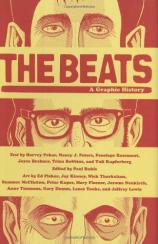The Beats: A Graphic History
Review
The Beats: A Graphic History
At its best, which is quite good indeed, The Beats reflects the creative energy of the movement it chronicles—it makes you want to dash off a poem before you have time to reconsider, or dust off your beret and organize some kind of jam session. Younger readers, in fact, might find inspiration in its pages while, one hopes, avoiding the excesses for which Jack Kerouac and his buddies are well known. If they do, credit largely goes to editor Paul Buhle, who has done an admirable job of presenting the “big picture” in terms of the Beats: One comes away with a sense that what counts is culture over the long haul, that personal demons take one out of the game and, obviously, diminish one’s legacy. The counter-examples provided to Kerouac’s sad flame-out are just too strong to ignore, whether it’s the way Allen Ginsburg turned to spirituality and became a champion of social justice or how William S. Burroughs, apparently relying on pure, dumb luck, survived to become a hero to the punk crowd, among others, in old age.
Remarkably comprehensive, The Beats isn’t content simply to spotlight the late-’50s explosion of the “beatnik” subculture onto the American scene. Instead, it traces its antecedents back to early 20th century circles of bohemians and left-wing artists/raconteurs, and also thoughtfully covers its influence on ’60s and ’70s counterculture through the lives of bridge-figures such as Tuli Kupferberg and LeRoi Jones/Amiri Baraka. Many of these connections are explicit, but some of them readers must make for themselves. That’s because the content isn’t presented in a single, cohesively epic sweep, but in an anthology format that takes individuals and “scenes” (e.g., City Lights Books) as the topics for its sections.
The rewards of this approach are many, as it allows the book’s contributors to spotlight more tangential personalities, even if only for a few pages at a time. In doing so, The Beats provides a platform for a variety of artists to fashion mini-bios of the figures that clearly move and inspire them; in this respect, the quietly transcendent profile of Philip Lamantia by Nancy Joyce Peters, Penelope Rosemont, and Summer McClinton comes to mind. But that’s not the only gem here.
There’s also the piece on Kenneth Patchen, drawn by Nick Thorkelson and cowritten with Harvey Pekar, which itself captures the innocent wisdom of this beloved poet-artist. Similarly, Peter Kuper (again working with Pekar, who scripted most of the book) supplies a mere two-page spread on Gary Snyder that nonetheless captures the meditative and nature-oriented tone of the subject’s work. Equally inventive is Mary Fleener’s portrait of Diane di Prima, in which each page-width panel resonates like a small mural. Resembling a conventional sequential narrative even less is Jerome Neurkirch’s piece on Slim Brundage, which manages to be fun and challenging at the same time.
In fact, so effective, surprising and delightful are such passages that one wishes a bit more of the book functioned this way, as a kind of “tribute album” by a wide range of talents in contemporary comics. Instead, the first half is dedicated to the lives of a handful of major figures and features the same creative team of Pekar and artist Ed Piskor for its entirety. Not that this section isn’t an engaging read, as the clearly well-researched text alternates crisply between the literary and the lurid. Rather, it’s a problem of proportion more than anything else—Piskor’s art, which relies on darkly humorous caricature and static portraits that often resemble demonic mug shots, is striking over the short run, but can get a bit exhausting over a hundred or so pages. On the other hand, stylistically his art is a perfect match for Pekar’s voice, which somehow manages to be simultaneously deadpan and sensationalistic. So if you’re already a fan of Pekar, his collaboration with Piskor here may be exactly what you’ll thrill to.
And to be fair, occasionally Piskor is nothing less than inspired himself, as in a two-panel page with an image of Buddha framed by the limitless night sky atop a shot of Kerouac, booze in hand, framed by a brick wall. This kind of subtlety, in which the art suggests levels of irony beyond the straightforward text, is present elsewhere in these pages…and of course mirrors the Beats’ own fascination with playfully juxtaposing art forms such as poetry and jazz. In fact, this marriage of the “multimodal” comics medium to the content is such a natural fit that one wonders why the graphic format didn’t discover the Beats earlier.
Reviewed by Courtney Kraft on April 13, 2010
The Beats: A Graphic History
- Publication Date: March 17, 2009
- Genres: Graphic Novel
- Hardcover: 208 pages
- Publisher: Hill and Wang
- ISBN-10: 0809094967
- ISBN-13: 9780809094967



